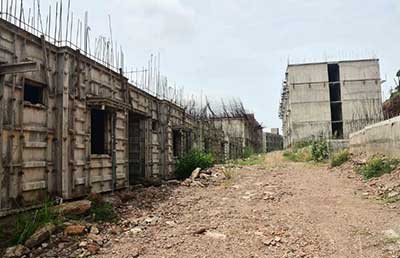Relevance: GS-3: Indian Economy and issues relating to Planning, Mobilisation of Resources, Growth, Development and Employment; Inclusive Growth and issues arising from it.
Key Phrases: UCBs and RCBs, increase credit availability; housing for all; Lack of sufficient due diligence; related lending; Lack of sufficient due diligence;
Why in News?
- Recently RBI has taken following decisions:
- Doubled the exposure limit for individual housing loans by Urban Co-operative Banks (UCBs) and Rural Co-operative Banks (RCBs).
- Allowed RCBs to lend to developers for residential housing projects.
- This move is welcomed but, it comes with risks.
Key Highlights
Reasons for the Decisions of RBI
- To increase credit availability for housing and construction
sectors.
- These sectors are critical for the economy, especially to recoup ground lost during Covid.
- To reduce the cost of construction of houses and to encourage it
to adjust to current times.
- Home loan rates and construction costs have risen steeply.
- The individual exposure limits last set in 2009 (for Home loans) and 2011 (construction) and hence required a change.
- For more accessible credit services to these sectors.
- Due to Cooperative Banks’ last-mile reach into the hinterland, they are better placed to cater to lower-income home-buyers than mainstream banks.
- For more credit options to these sectors.
- Housing Finance Companies (HFCs) are more regulated by RBI after the DHFL debacle.
- This makes banks the primary funding source for home loans.
- To achieve the targets of PMAY within the stipulated time.
- 2022 is supposed to be the final year to achieve the “Housing for All” targets set under the PM Awas Yojana (PMAY, launched in 2015).
- Policymakers are keen to ensure that the credit flow to the housing sector, particularly affordable homes, doesn’t slow.
- As per RBI’s latest data, while overall bank credit to housing grew 13.7% in May 2022 (y-o-y), credit to the affordable segment grew by only 4.6%.
Do you know?
- A co-operative bank is a small-sized, financial entity, where its members are the owners and customers of the Bank.
- The Co-operative Banks in India are governed as per
- the Banking Regulations Act 1949 and
- Banking Laws (Co-operative Societies) Act, 1955.
- These Banks have been opened with the motto of ‘no-profit-no-loss’ and thus, do not seek for profitable ventures and customers only. As the name suggests, the main objective of Co-operative Banks is mutual help.
- They are regulated by the Reserve Bank of India (RBI) and are registered under the States Cooperative Societies Act.
- Till the year 1996 UCBs were allowed to lend money only for non-agricultural purposes. This distinction does not hold today.
- Of the total number of Cooperative Banks in India, they can be
divided into two types, which can further be subdivided:
- Urban Co-operative Banks
- Non-Scheduled UCBs
- Scheduled UCBs
- Rural Co-operative Banks
- State Cooperative Banks
- District Central Cooperative Banks
- Primary Agricultural Credit Societies
- Urban Co-operative Banks
- Single-State UCBs are regulated by State Registrars of Co-operative Societies (RCS) and multi-State UCBs are governed by Central Registrar of Co-operative Societies (CRCS).
- By definition, any bank which is listed in the 2nd schedule of the Reserve Bank of India Act, 1934 is considered a scheduled bank.
Challenges/ Risks Involved
- Lack of sufficient due diligence
- It can be speculated that these banks will not put in sufficient due diligence on the repayment capacity or end-use of funds while underwriting new borrowers.
- Monitoring end-user will prove to be tough.
- This is particularly true of cooperative banks lending to developers for residential real estate.
- Enforcing the cooperative banks' limits will prove tough due to
related-party lending.
- RBI has set limits at
- 5% of total assets for developer loans,
- 15% of capital for individual borrowers and
- 40% for a group
- Cooperative banks are smaller and loosely governed.
- RBI has set limits at
- Maintaining vigil over cooperative banks may strain RBI’s regulatory
capacity
- The sheer number of UCBs and RCBs (at end-March 2021, there were 98,042 cooperative banks, comprising 1,534 UCBs and 96,508 RCBs) are now falling under its ambit.
Case Study : PMC Bank
- Its troubles originated from nearly half of its loan book being concentrated with a single related-party developer HDIL.
- With the help of fictitious borrower accounts, it was able to conceal its violation of RBI’s prudential limits.
Steps Taken to Improve the Cooperative Banking Ecosystem
- The Banking Regulation Act has been amended to give RBI complete
regulatory control over co-operative banks, in place of dual regulation.
- RBI can restructure poor-performing cooperative banks. This has increased the accountability of cooperative banks.
- RBI now has
- power to approve top management appointments in co-operative banks;
- tightened cooperative banks’ technology, risk management and audit functions and
- call for more frequent financial filings.
Conclusion
- RBI may need to significantly augment both its manpower and technological capabilities to enforce its writ on co-operative banks. A resurgent India will require the right to adequate shelter for all, along with, ease of living for all, and hence, the recent move becomes important.
Source: The Hindu BL
Mains Question:
Q. Discuss the changes proposed by RBI vis-a-vis Home loans by Cooperative Banks and the challenges associated with it?








